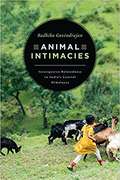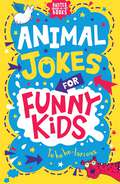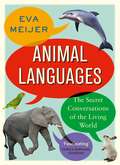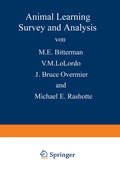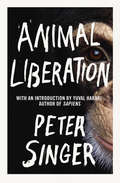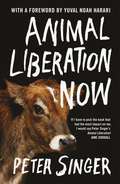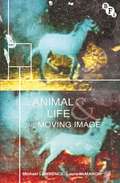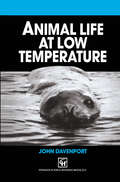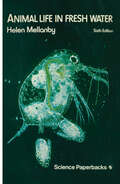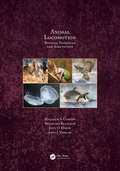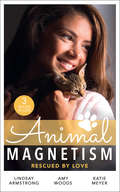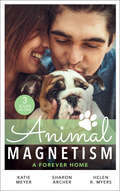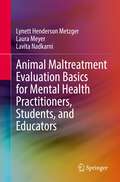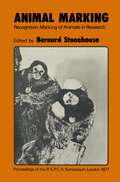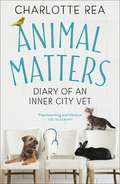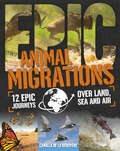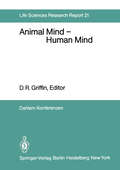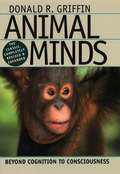- Table View
- List View
Animal Intimacies: Interspecies Relatedness in India's Central Himalayas (Animal Lives)
by Radhika GovindrajanWhat does it mean to live and die in relation to other animals? Animal Intimacies posits this central question alongside the intimate—and intense—moments of care, kinship, violence, politics, indifference, and desire that occur between human and non-human animals. Built on extensive ethnographic fieldwork in the mountain villages of India’s Central Himalayas, Radhika Govindrajan’s book explores the number of ways that human and animal interact to cultivate relationships as interconnected, related beings. Whether it is through the study of the affect and ethics of ritual animal sacrifice, analysis of the right-wing political project of cow-protection, or examination of villagers’ talk about bears who abduct women and have sex with them, Govindrajan illustrates that multispecies relatedness relies on both difference and ineffable affinity between animals. Animal Intimacies breaks substantial new ground in animal studies, and Govindrajan’s detailed portrait of the social, political and religious life of the region will be of interest to cultural anthropologists and scholars of South Asia as well.
Animal Jokes for Funny Kids
by Andrew Pinder Josephine SouthonA new title in the 'Buster Laugh-a-Lot' series, this paw-some collection has hundreds of hilarious animal-themed jokes for funny kids to share.Why do dogs run in circles?Because it’s hard to run in squares!How does a lion greet other animals?"Pleased to eat you."Why are frogs always so happy?They eat whatever bugs them.Filled with over 300 hiss-terical and a-moo-sing animal jokes that will have ewe in stitches, including one-liners, ridiculous puns, tongue twisters and much more. Designed to be easy to read with wonderfully silly illustrations for extra laughs, this laugh-out-loud collection will keep jokers entertained for hours on end.
Animal Languages: The secret conversations of the living world
by Eva MeijerDolphins and parrots call each other by their names. Fork tailed drongos mimic the calls of other animals to scare them away and then steal their dinner. In the songs of many species of birds, and in skin patterns of squid, we find grammatical structures . . .If you are lucky, you might meet an animal that wants to talk to you. If you are even luckier, you might meet an animal that takes the time and effort to get to know you. Such relationships can teach us not only about the animal in question, but also about language and about ourselves.From how prairie dogs describe intruders in detail -- including their size, shape, speed and the colour of their hair and T-shirts -- to how bats like to gossip, to the impressive greeting rituals of monogamous seabirds, Animal Languages is a fascinating and philosophical exploration of the ways animals communicate with each other, and with us. Researchers are discovering that animals have rich and complex languages with grammatical and structural rules that allow them to strategise, share advice, give warnings, show love and gossip amongst themselves. Animal Languages will reveal this surprising hidden social life and show you how to talk with the animals.
Animal Learning: Survey and Analysis (Nato Science Series A: #19)
by M. E. Bitterman V. M. LoLordo J. Bruce Overmier Michael E. RashotteFor ten days, a number of neuroscientists met at Reisensburg to attend a series of lectures and discussions, an Institute, on animal learning. The students were drawn from a wide variety of disciplines, including anatomy, biochemistry, pharmacology, physiol ogy and zoology. It is probably true to say that many of them had at best a sketchy knowledge about the learning behavior of animals, about the conditions which are necessary for learning to take place and about the theories that psychologists have constructed about the learning processes. Was the Institute of any benefit to those neuro scientists whose interests lay in studying the functioning of the nervous system by manipulating it or probing it in some direct way? Some twenty years ago the answer to this question would probably have been "No"; and there is a very good reason why this view might have been held, especially by students of the mammalian nervous system. At that time most investigators used anaesthetised animals, or animals immobilized in some other way such as by surgically isolating the brain from the spinal cord, by dividing the brain at various levels or through the use of paralyzing agents. These con ditions achieved two things. On the one hand, they allowed sub stantial advances to be made, particularly in the analysis of sensory processing and in the analysis of the neuronal mechanisms of relatively simple reflex action. On the other hand, the experi mental conditions virtually eliminated complex behavior.
Animal Liberation: Towards An End To Man's Inhumanity To Animals
by Peter SingerHow should we treat non-human animals? In this immensely powerful and influential book (now with a new introduction by Sapiens author Yuval Noah Harari), the renowned moral philosopher Peter Singer addresses this simple question with trenchant, dispassionate reasoning. Accompanied by the disturbing evidence of factory farms and laboratories, his answers triggered the birth of the animal rights movement.'An extraordinary book which has had extraordinary effects... Widely known as the bible of the animal liberation movement' Independent on SundayIn the decades since this landmark classic first appeared, some public attitudes to animals may have changed but our continued abuse of animals in factory farms and as tools for research shows that the underlying ideas Singer exposes as ethically indefensible are still dominating the way we treat animals. As Yuval Harari’s brilliantly argued introduction makes clear, this book is as relevant now as the day it was written.
Animal Liberation Now
by Peter SingerNow fully rewritten and entirely updated to reflect the pressing problems of today, Animal Liberation Now presents the definitive case for radically rethinking humanity's relationship with other animals'Widely recognized as the foundational text within the animal liberation movement, Peter Singer's Animal Liberation opened my eyes to the radical philosophy that all animals are worthy of equal consideration. Singer's latest, Animal Liberation Now, will motivate a new generation of readers who are resolutely committed to creating a just society for all' Joaquin Phoenix'The indispensable foundational text for the movement, new and updated. Animal Liberation Now is written with the honesty and philosophical depth characteristic of all of Singer's work' J. M. Coetzee, Winner of the Nobel Prize in Literature, author of The Lives of Animals and Disgrace'If I have to pick the book that had the most impact on me, I would say Peter Singer's Animal Liberation, since I instantly became a vegetarian after reading it' Jane Goodall'Probably the single most influential document in the history of ... animal welfare' Guardian____In 1975, Animal Liberation started a worldwide movement when it revealed the abuse of animals in factory farms and laboratories. It demonstrated that these and other practices were the cause of appalling and unnecessary suffering and therefore morally indefensible. In the fifty years since, science has further vindicated Peter Singer's arguments about animal sentience, vegetarianism has become widespread, and the book has helped change the minds of millions. But the situation for animals has in many ways grown worse.Despite improvements in animal welfare in some regions - brought about in large part by this book - in many others the scale of their abuse has reached staggering new depths. This revised edition, of which about two-thirds is entirely new, documents these and other developments, such as the impact of meat consumption on climate and the spread of dangerous new viruses. It refines its arguments in light of new evidence, equips the reader with fresh tools and advice, and shows us all the road ahead. The result, Animal Liberation Now, is a book of galvanising power, relevance and importance.____'A reasoned plea for the humane treatment of animals that galvanised the animal-rights movement the way the Rachel Carson's Silent Spring drew activists to environmentalism' The New York Times'An extraordinary book which has had extraordinary effects ... It galvanised a generation into action' Independent on Sunday'Raises ethical questions that every human being should take to heart' Yuval Noah Harari'One the most important books of the last 100 years. It expands our moral horizons beyond our own species' EcologistOne of the 100 all-time best non-fiction books* (TIME magazine)
Animal Life and the Moving Image
by Michael Lawrence Laura McMahonFrom the proto-cinematic sequencing of animal motion in the nineteenth century to the ubiquity of animal videos online, the histories of animal life and the moving image are enigmatically interlocked. Animal Life and the Moving Image is the first collection of essays to offer a sustained focus on the relations between screen cultures and non-human animals. The volume brings together some of the most important and influential writers working on the non-human animal's significance for cultures and theories of the moving image. It offers innovative analyses of the representation of animals across a wide range of documentary, fiction, mainstream and avant-garde practices, from early cinema to contemporaryuser-generated media. Individual chapters consider King Kong, The Birds, The Misfits, The Cove, Grizzly Man and Microcosmos, the work of Sergei Eisenstein, Robert Bresson, Malcolm Le Grice, Peter Greenaway, Carolee Schneemann and Isabella Rossellini, and YouTube stars Christian the lion and Maru the cat.
Animal Life and the Moving Image
by Michael Lawrence Laura McMahonFrom the proto-cinematic sequencing of animal motion in the nineteenth century to the ubiquity of animal videos online, the histories of animal life and the moving image are enigmatically interlocked. Animal Life and the Moving Image is the first collection of essays to offer a sustained focus on the relations between screen cultures and non-human animals. The volume brings together some of the most important and influential writers working on the non-human animal's significance for cultures and theories of the moving image. It offers innovative analyses of the representation of animals across a wide range of documentary, fiction, mainstream and avant-garde practices, from early cinema to contemporaryuser-generated media. Individual chapters consider King Kong, The Birds, The Misfits, The Cove, Grizzly Man and Microcosmos, the work of Sergei Eisenstein, Robert Bresson, Malcolm Le Grice, Peter Greenaway, Carolee Schneemann and Isabella Rossellini, and YouTube stars Christian the lion and Maru the cat.
Animal Life at Low Temperature
by John DavenportTo humans, cold has a distinctly positive quality. 'Frostbite', 'a nip in the air', 'biting cold', all express the concept of cold as an entity which attacks the body, numbing and damaging it in the process. Probably the richness of descriptive English in this area stems from the early experiences of a group of essentially tropical apes, making their living on a cold and windswept island group half way between the Equator and the Arctic. During a scientific education we soon learn that there is no such thing as cold, only an absence of heat. Cold does not invade us; heat simply deserts. Later still we come to appreciate that temperature is a reflection of kinetic energy, and that the quantity of kinetic energy in a system is determined by the speed of molecular movement. Despite this realization, it is difficult to abandon the sensible prejudices of palaeolithic Homo sapiens shivering in his huts and caves. For example; appreciating that a polar bear is probably as comfortable when swimming from ice floe to ice floe as we are when swimming in the summer Mediterranean is not easy; understanding the thermal sensa tions of a 'cold-blooded' earthworm virtually impossible. We must always be wary of an anthropocentric attitude when considering the effects of cold on other species.
Animal Life in Fresh Water: A Guide to Fresh-Water Invertebrates
by Helen Mellanbyby Professor L. E. Eastham Formerly Professor of Zoology in the University of Sheffield Most books are written with the intention of supplying some particular need, but few end with such single purpose. Mrs. Mellanby's is no exception, for while the author planned this work to serve as a guide to the school pupil, which function it fulfils in an admirable way, it will also prove of value to the teacher, the university student and the amateur naturalist. While it may be argued that it is not the function of the Uni versities to teach Natural History in the commonly accepted sense, it will always be the aim of Zoologists to know more about animals, what they are and do, where they live and why they live in particular environments. It is unfortunate, in view of the fact that the majority of students of Zoology enter the teaching pro fession, that the increasing load of instruction in morphology, physiology, cytology, genetics, evolution and the like frequently makes a personal study of animal life in relation to environment almost impossible. The fortunate ones visit the sea for a fort night's course in Marine Ecology; the others take posts in schools without even this respite and set about converting their academic learning to a school curriculum. The result is an undesirable and often slavish imitation of university method in the school class room.
Animal Locomotion: Physical Principles and Adaptations
by Malcolm S. Gordon Reinhard Blickhan John O. Dabiri John J. VidelerAnimal Locomotion: Physical Principles and Adaptations is a professional-level, state of the art review and reference summarizing the current understanding of macroscopic metazoan animal movement. The comparative biophysics, biomechanics and bioengineering of swimming, flying and terrestrial locomotion are placed in contemporary frameworks of biodiversity, evolutionary process, and modern research methods, including mathematical analysis. The intended primary audience is advanced-level students and researchers primarily interested in and trained in mathematics, physical sciences and engineering. Although not encyclopedic in its coverage, anyone interested in organismal biology, functional morphology, organ systems and ecological physiology, physiological ecology, molecular biology, molecular genetics and systems biology should find this book useful.
Animal Locomotion: Physical Principles and Adaptations
by Malcolm S. Gordon Reinhard Blickhan John O. Dabiri John J. VidelerAnimal Locomotion: Physical Principles and Adaptations is a professional-level, state of the art review and reference summarizing the current understanding of macroscopic metazoan animal movement. The comparative biophysics, biomechanics and bioengineering of swimming, flying and terrestrial locomotion are placed in contemporary frameworks of biodiversity, evolutionary process, and modern research methods, including mathematical analysis. The intended primary audience is advanced-level students and researchers primarily interested in and trained in mathematics, physical sciences and engineering. Although not encyclopedic in its coverage, anyone interested in organismal biology, functional morphology, organ systems and ecological physiology, physiological ecology, molecular biology, molecular genetics and systems biology should find this book useful.
Animal Magnetism: The Socialite And The Cattle King / Puppy Love For The Veterinarian / The Puppy Proposal (Harlequin Ser.)
by Lindsay Armstrong Amy Woods Katie MeyerA new leash on love
Animal Magnetism: A Valentine For The Veterinarian / Single Father: Wife And Mother Wanted / Groomed For Love (Mills And Boon M&b Ser.)
by Katie Meyer Sharon Archer Helen R. MyersPurr-fect for each other
Animal Magnetism: The Rebel Heir's Bride (the Randell Brotherhood) / The Most Expensive Lie Of All / Marrying Dr. Maverick (Mills And Boon M&b Ser.)
by Patricia Thayer Michelle Conder Karen Rose SmithA dark horse
Animal Maltreatment Evaluation Basics for Mental Health Practitioners, Students, and Educators
by Lynett Henderson Metzger Laura Meyer Lavita NadkarniThis book provides a brief introduction to the growing field of animal maltreatment evaluation and treatment, with a special emphasis on clinical training from a forensic psychology perspective. Geared toward mental health practitioners, students, and educators, this broad overview focuses on foundational legal concepts, applications in clinical and psycholegal settings, and emerging perspectives on effective evaluation and treatment. The authors provide practical guidance around “real world” scenarios through the use of clinical case vignettes, highlighting the complexities and need for culturally- and psychologically-informed care in these cases. Key topics include forensic animal maltreatment evaluations (or FAMEs); implications for best practices; challenges for providers, trainees, and supervisors; and future directions for the field.
Animal Matters: Diary of an Inner City Vet
by Charlotte Rea'Heartwarming and hilarious' Telegraph'With as many horrifying stories as heart-warming ones, this is a fascinating look at the year in the life of a vet at a London animal charity hospital. There are some proper belly laughs as well as some insights that will truly stick with you.' - Alexandra Heminsley, GraziaAn unusual 'dalmation', a TV star with cancer, an out of control budgie. Charlotte Rea has seen them all, and more. Animal Matters is Charlotte's diary of real-life cases written during a one year of her work as a veterinary surgeon in a 24-hour inner-city London animal charity. The diary reveals the reality of working as a vet, how it can be both emotional and amusing, one minute you can be consoling an owner on the loss of their much-loved pet, the next trying to catch an escaped budgie. Charlotte mixes deeply sad moments with amusing and unimaginable ones along with more detailed accounts and reflections back on her training and the experiences she has come up against over the decade since she graduated. Throughout the book you will get to know both the animals and the people and how close the bond between us can be. Charlotte also discusses contemporary issues in veterinary medicine such as animal euthanasia, RSPCA welfare cases, mental health issues within the veterinary profession, ethical concerns around pedigree dog breeding and the laws on dangerous dogs. Animal Matters is a moving and heartwarming book about the unconditional love between animals and humans.
Animal Migrations: Animal Migrations (Epic! #3)
by Camilla De La BedoyereEpic: Animal Migrations focuses on 12 of the most remarkable animal migrations in the world, from the monarch butterfly, which weighs no more than a pea, but journeys all the way across North America each year, to the leatherback turtle, which migrates across an entire ocean to breed. The book details the timespan and location of each migration, the reasons involved and the method used. A timeline on every spread gives the time frame for each migration, and what happens when. Additional background information to each animal is also provided, including the wildebeest, the Arctic tern, the caribou, the gray whale, the European eel, the Sockeye salmon, the dragonfly, the straw-coloured fruit bat, zooplankton and the Christmas Island red crab. Epic: Animal Migrations also looks at the science behind each migration, and how the animals know where and when to go. Infographic elements on each spread present information in a simple and highly visual way. Clear, concise text and a bright, appealing design make the book the perfect resource for project work on habitats, adaptation, genetics and inheritance, or simply a great leisure read, for children aged 9 and above.For more epic events, try reading the other titles in the Epic series: Battles, Empires and Explorers.
Animal Mind — Human Mind: Report of the Dahlem Workshop on Animal Mind — Human Mind, Berlin 1981, March 22–27 (Dahlem Workshop Report #21)
by M. Dawkins W. Kintsch H. J. Neville R. M. Seyfarth D. R. Griffin J. F. Bennett D. Dörner S. A. Hillyard B. K. Hölldobler H. S. Markl P. R. Marler D. Premackthe oleic acid on a live and wriggling sister or mother and refrain from evicting her from our hive. But does the occur rence of unintelligent behavior suffice to demonstrate the total absence of mental experience under any circumstances? Ethologists from some distant galaxy could easily discern ex amples of stupid and maladaptive behavior in our own species. But do instances of human stupidity prove that none of us is ever consciously aware of what he is dOing? No available evi dence compels us to believe that insects, or any other animals, experience any sort of consciousness, or intentionally plan any of their behavior. But neither are we compelled to believe the contrary. In areas where data are few and of limited rel evance, dogmatic negativity can easily limit what scientists even try to investigate, and thus perhaps delay or prevent im portant insights and discoveries. Many of the participants agreed that a good starting point would be to consider what we know of our own thinking, subjec tive feelings, and consciousness, and then move on to inquire whether other species experience anything similar. Such an ap proach was once considered fallaciously anthropomorphic. But it seems now to be widely if not universally recognized that this is a serious objection only if one has already assumed in advance that conscious thinking is uniquely human, and the accu sation of anthropomorphism is then merely a reiteration of the prior conviction.
Animal Minds: Beyond Cognition to Consciousness
by Donald R. GriffinIn Animal Minds, Donald R. Griffin takes us on a guided tour of the recent explosion of scientific research on animal mentality. Are animals consciously aware of anything, or are they merely living machines, incapable of conscious thoughts or emotional feelings? How can we tell? Such questions have long fascinated Griffin, who has been a pioneer at the forefront of research in animal cognition for decades, and is recognized as one of the leading behavioral ecologists of the twentieth century. With this new edition of his classic book, which he has completely revised and updated, Griffin moves beyond considerations of animal cognition to argue that scientists can and should investigate questions of animal consciousness. Using examples from studies of species ranging from chimpanzees and dolphins to birds and honeybees, he demonstrates how communication among animals can serve as a "window" into what animals think and feel, just as human speech and nonverbal communication tell us most of what we know about the thoughts and feelings of other people. Even when they don't communicate about it, animals respond with sometimes surprising versatility to new situations for which neither their genes nor their previous experiences have prepared them, and Griffin discusses what these behaviors can tell us about animal minds. He also reviews the latest research in cognitive neuroscience, which has revealed startling similarities in the neural mechanisms underlying brain functioning in both humans and other animals. Finally, in four chapters greatly expanded for this edition, Griffin considers the latest scientific research on animal consciousness, pro and con, and explores its profound philosophical and ethical implications.
Animal Minds: Beyond Cognition to Consciousness
by Donald R. GriffinIn Animal Minds, Donald R. Griffin takes us on a guided tour of the recent explosion of scientific research on animal mentality. Are animals consciously aware of anything, or are they merely living machines, incapable of conscious thoughts or emotional feelings? How can we tell? Such questions have long fascinated Griffin, who has been a pioneer at the forefront of research in animal cognition for decades, and is recognized as one of the leading behavioral ecologists of the twentieth century. With this new edition of his classic book, which he has completely revised and updated, Griffin moves beyond considerations of animal cognition to argue that scientists can and should investigate questions of animal consciousness. Using examples from studies of species ranging from chimpanzees and dolphins to birds and honeybees, he demonstrates how communication among animals can serve as a "window" into what animals think and feel, just as human speech and nonverbal communication tell us most of what we know about the thoughts and feelings of other people. Even when they don't communicate about it, animals respond with sometimes surprising versatility to new situations for which neither their genes nor their previous experiences have prepared them, and Griffin discusses what these behaviors can tell us about animal minds. He also reviews the latest research in cognitive neuroscience, which has revealed startling similarities in the neural mechanisms underlying brain functioning in both humans and other animals. Finally, in four chapters greatly expanded for this edition, Griffin considers the latest scientific research on animal consciousness, pro and con, and explores its profound philosophical and ethical implications.
Animal Minds: Beyond Cognition to Consciousness
by Donald R. GriffinIn Animal Minds, Donald R. Griffin takes us on a guided tour of the recent explosion of scientific research on animal mentality. Are animals consciously aware of anything, or are they merely living machines, incapable of conscious thoughts or emotional feelings? How can we tell? Such questions have long fascinated Griffin, who has been a pioneer at the forefront of research in animal cognition for decades, and is recognized as one of the leading behavioral ecologists of the twentieth century. With this new edition of his classic book, which he has completely revised and updated, Griffin moves beyond considerations of animal cognition to argue that scientists can and should investigate questions of animal consciousness. Using examples from studies of species ranging from chimpanzees and dolphins to birds and honeybees, he demonstrates how communication among animals can serve as a "window" into what animals think and feel, just as human speech and nonverbal communication tell us most of what we know about the thoughts and feelings of other people. Even when they don't communicate about it, animals respond with sometimes surprising versatility to new situations for which neither their genes nor their previous experiences have prepared them, and Griffin discusses what these behaviors can tell us about animal minds. He also reviews the latest research in cognitive neuroscience, which has revealed startling similarities in the neural mechanisms underlying brain functioning in both humans and other animals. Finally, in four chapters greatly expanded for this edition, Griffin considers the latest scientific research on animal consciousness, pro and con, and explores its profound philosophical and ethical implications.
Animal Minds: Beyond Cognition to Consciousness
by Donald R. GriffinIn Animal Minds, Donald R. Griffin takes us on a guided tour of the recent explosion of scientific research on animal mentality. Are animals consciously aware of anything, or are they merely living machines, incapable of conscious thoughts or emotional feelings? How can we tell? Such questions have long fascinated Griffin, who has been a pioneer at the forefront of research in animal cognition for decades, and is recognized as one of the leading behavioral ecologists of the twentieth century. With this new edition of his classic book, which he has completely revised and updated, Griffin moves beyond considerations of animal cognition to argue that scientists can and should investigate questions of animal consciousness. Using examples from studies of species ranging from chimpanzees and dolphins to birds and honeybees, he demonstrates how communication among animals can serve as a "window" into what animals think and feel, just as human speech and nonverbal communication tell us most of what we know about the thoughts and feelings of other people. Even when they don't communicate about it, animals respond with sometimes surprising versatility to new situations for which neither their genes nor their previous experiences have prepared them, and Griffin discusses what these behaviors can tell us about animal minds. He also reviews the latest research in cognitive neuroscience, which has revealed startling similarities in the neural mechanisms underlying brain functioning in both humans and other animals. Finally, in four chapters greatly expanded for this edition, Griffin considers the latest scientific research on animal consciousness, pro and con, and explores its profound philosophical and ethical implications.
Animal Minds: Beyond Cognition to Consciousness
by Donald R. GriffinIn Animal Minds, Donald R. Griffin takes us on a guided tour of the recent explosion of scientific research on animal mentality. Are animals consciously aware of anything, or are they merely living machines, incapable of conscious thoughts or emotional feelings? How can we tell? Such questions have long fascinated Griffin, who has been a pioneer at the forefront of research in animal cognition for decades, and is recognized as one of the leading behavioral ecologists of the twentieth century. With this new edition of his classic book, which he has completely revised and updated, Griffin moves beyond considerations of animal cognition to argue that scientists can and should investigate questions of animal consciousness. Using examples from studies of species ranging from chimpanzees and dolphins to birds and honeybees, he demonstrates how communication among animals can serve as a "window" into what animals think and feel, just as human speech and nonverbal communication tell us most of what we know about the thoughts and feelings of other people. Even when they don't communicate about it, animals respond with sometimes surprising versatility to new situations for which neither their genes nor their previous experiences have prepared them, and Griffin discusses what these behaviors can tell us about animal minds. He also reviews the latest research in cognitive neuroscience, which has revealed startling similarities in the neural mechanisms underlying brain functioning in both humans and other animals. Finally, in four chapters greatly expanded for this edition, Griffin considers the latest scientific research on animal consciousness, pro and con, and explores its profound philosophical and ethical implications.
